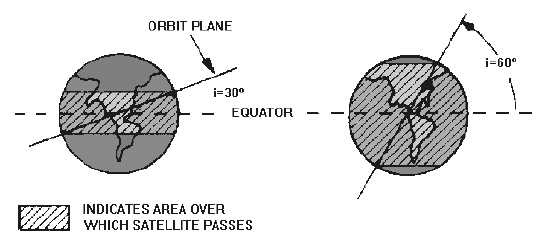4-5
Figure 4-4.—Effect of orbit plane inclination on satellite coverage.
SPECIAL TYPES OF INCLINED ORBITS.—A satellite orbiting in a plane that coincides with
the equatorial plane of the earth is in an EQUATORIAL ORBIT. A satellite orbiting in an inclined orbit
with an angle of inclination of 90 degrees or near 90 degrees is in a POLAR ORBIT.
SPECIAL TYPES OF CIRCULAR ORBITS.—We stated previously that a circular orbit is a
special type of elliptical orbit. You should realize a circular orbit is one in which the major and minor axis
distances are equal or approximately equal. Mean height above earth, instead of perigee and apogee, is
used in describing a circular orbit. While we are discussing circular orbits, you should look at some of the
terms mentioned earlier in this chapter. A satellite in a circular orbit at a height of approximately 19,300
nautical miles above the earth is in a synchronous orbit. At this altitude the period of rotation of the
satellite is 24 hours, the same as the rotation period of the earth. In other words, the orbit of the satellite is
in sync with the rotational motion of the earth. Although inclined and polar synchronous orbits are
possible, the term synchronous usually refers to a synchronous equatorial orbit. In this type of orbit,
satellites appear to hover motionlessly in the sky. Figure 4-5 shows how one of these satellites can
provide coverage to almost half the surface of the earth.
Figure 4-5.—Illumination from a synchronous satellite.



